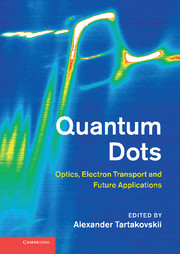Book contents
- Frontmatter
- Contents
- List of contributors
- Preface
- Part I Nanostructure design and structural properties of epitaxially grown quantum dots and nanowires
- Part II Manipulation of individual quantum states in quantum dots using optical techniques
- Part III Optical properties of quantum dots in photonic cavities and plasmon-coupled dots
- Part IV Quantum dot nano-laboratory: magnetic ions and nuclear spins in a dot
- Part V Electron transport in quantum dots fabricated by lithographic techniques from III–V semiconductors and graphene
- Part VI Single dots for future telecommunications applications
- 18 Electrically operated entangled light sources based on quantum dots
- 19 Deterministic single quantum dot cavities at telecommunication wavelengths
- Index
- References
18 - Electrically operated entangled light sources based on quantum dots
from Part VI - Single dots for future telecommunications applications
Published online by Cambridge University Press: 05 August 2012
- Frontmatter
- Contents
- List of contributors
- Preface
- Part I Nanostructure design and structural properties of epitaxially grown quantum dots and nanowires
- Part II Manipulation of individual quantum states in quantum dots using optical techniques
- Part III Optical properties of quantum dots in photonic cavities and plasmon-coupled dots
- Part IV Quantum dot nano-laboratory: magnetic ions and nuclear spins in a dot
- Part V Electron transport in quantum dots fabricated by lithographic techniques from III–V semiconductors and graphene
- Part VI Single dots for future telecommunications applications
- 18 Electrically operated entangled light sources based on quantum dots
- 19 Deterministic single quantum dot cavities at telecommunication wavelengths
- Index
- References
Summary
Introduction
Quantum information technology promises to offer incredible advantages over current digital systems, allowing intractable problems in science and engineering to be tackled almost instantaneously through quantum computing, and unconditionally secure communication over long distances using quantum key distribution. Many schemes have been developed to implement quantum computing, including using linear optics [28]. The linear optical approach has proved popular due to the limited decoherence of photons with the environment, and accessibility of the components required for simple experiments. At the heart of an optical quantum computer, or extended range quantum key distribution using quantum relays or repeaters [14, 8, 24], lie entangled photons. The characteristics of the sources that create entangled photons, and their properties, are therefore central to realizing the full potential of such applications.
Quantum dots are one technology with which entangled light sources can be built [6]. Although first realised only relatively recently [49], they in principle offer key fundamental and practical advantages over other entangled photon sources. In the fundamental sense, quantum dots can be triggered, so that no more than one entangled photon pair is emitted at a time. This is in stark contrast to Poissonian entangled light sources [47, 27, 13], including the most widely used parametric down-conversion, where zero or multiple photon-pairs are usually emitted due to their probabilistic nature. Furthermore quantum dots have the potential to operate with high efficiency, with current experiments reporting up to 72% collection efficiency for the first and second photon [9, 12].
- Type
- Chapter
- Information
- Quantum DotsOptics, Electron Transport and Future Applications, pp. 319 - 340Publisher: Cambridge University PressPrint publication year: 2012



